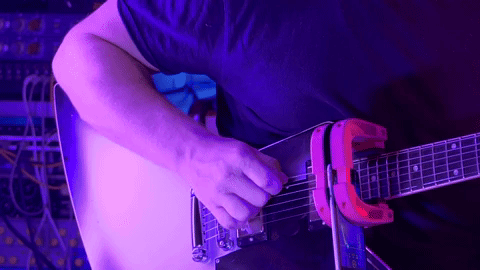Primary Motion And Musical Style
One factor which we think exerts a strong influence on the choice of primary motion is the musical style you’re trying to play when you’re first learning.
Evidence suggests that familiarity and recency is what guides the motor system’s choices about which motions to learn and retain in long-term memory. The first motion you discover which is capable of successfully playing a particular phrase is the one you’re likely to retain, even if more experimentation could eventually locate other motions capable of accomplishing the same goal.
What this is means is that choosing a musical style can influence the process of learning core motions if that choice changes the technical requirements of the phrases you’re working on.
Single Escape Primary Motion
For example, when we film players who initially learned picking technique while trying to play faster styles like rock and jazz, we notice that their primary motions are frequently single-escape motions like USX and DSX. The use of Elbow motion for tremolo is a common example of this — here’s Brendon Small’s awesome elbow technique:

When your goal is playing really fast metal tremolo, elbow motion is an effective way of doing that. It’s also a simple joint that pretty much only moves one way. If we’re thinking in terms of degrees of freedom, it’s easy to imagine how a self-taught beginner who is proceeding by experimentation might be able to figure out this technique sooner than other more complicated techniques.
That’s our hypothesis, and it’s backed up by teaching experience where we ask new players to try moving as fast as they can without thinking too much about it. When we do this simple test, single escape motions like elbow, forearm, or single-axis wrist motion are usually the ones players discover, even if we don’t give them any other hints beyond the simple instruction to “go fast”.
Double Escape Primary Motion
By comparison, when you look at players who learned their techniques while playing bluegrass, you start to see a lot more primary double escape players. Here’s Winfield champion Carl Miner’s DBX pickstroke:

Expert flat pickers like Carl, Molly Tuttle, and David Grier learned picking technique in a style of music where straight-line speed wasn’t the first thing they were told to achieve. Instead, they played Bluegrass standards — short songs driven mainly by melodies where all the notes are typically picked.
While musically simple, bluegrass melodies don’t often follow regular patterns of upstroke or downstroke string changes, so it’s actually tricky to figure out how to play them with single escape motions. Doing so involves inserting legato notes like pull-offs and hammer-ons, or rearranging phrases on the fretboard, to change the number of picked notes per string. Bluegrass repertoire also includes roll patterns, which are one-note-per-string arpeggio phrases that actually require double escape motion when performed with alternate picking. So those phrases are hard bottlenecks that really can’t be done with single escape, at least not if alternate picking is the approach you’re using.
When you take all these requirements into consideration, it’s easy to imagine that the first motion a beginner hits upon that can actually satisfy them all is a double escape motion, even if learning it might not be as obvious as simply moving the elbow back and forth.